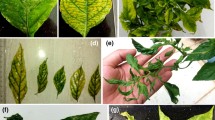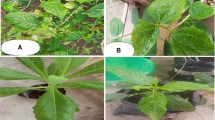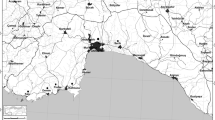Abstract
Lanzhou lily (Lilium davidii var. unicolor) with symptoms of severe fasciation or dwarfing was observed in the central region of Gansu province, and the disease caused a serious loss in production of the bulb edible crop. In order to determine possible virus infections involved in the described disease, a set of enzyme-linked immunosorbent assays and immunoelectron microscopy had been performed to test the naturally infected plants. A mixed infection which includes Lily symptomless virus (LSV: Flexiviridae, Carlavirus), Cucumber mosaic virus (CMV: Bromoviridae, Cucumovirus) and Lily mottle virus (LMoV: Potyviridae, Potyvirus) has been confirmed by serologic and morphologic evidences. The subsequent thin sectioning observation with a transmission electron microscope on different tissues from infected samples showed that cytopathologic damages happened. Total RNA extracted from different tissues of infected plants was used in the Northern-blotting assays with probes of coat protein gene of each virus, then hybridization data showed a symptomatic infection of related virus. Thus, the study gives reliable serologic, morphologic, cytopathologic and molecular evidences for the diagnosis of the systemic infections. This study is hoped to be useful in prevention of certain viral diseases and to increase the quality and production of this crop in the future.
Zusammenfassung
Lanzhou-Lilien (Lilium davidii var. unicolor) mit deutlichen Verbänderungs- und Verzwergungssymptomen wurden im Herzen der nordwestchinesischen Provinz Gansu beobachtet. Die Erkrankung verursachte schwere Ertragsverluste beim Anbau der essbaren Lilienzwiebeln. Zur Diagnose möglicher Virusinfektionen wurden verschiedene enzymgekoppelte Immunadsorptionstests (ELISA) und Immunelektronenmikroskopie an natürlich infizierten Pflanzen durchgeführt. Eine Mischinfektion mit dem Symptomlosen Lilienvirus (Lily symptomless virus, LSV: Flexiviridae, Carlavirus), Gurkenmosaikvirus (Cucumber mosaic virus, CMV: Bromoviridae, Cucumovirus) und dem Lilienfleckenvirus (Lily mottle virus, LMoV: Potyviridae, Potyvirus) wurde serologisch und morphologisch bestätigt. Die transmissionselektronenmikroskopische Untersuchung von Gewebe-Dünnschnitten zeigte cytopathologische Veränderungen. Die Gesamt-RNA verschiedener Gewebe infizierter Pflanzen konnte im Northern-Blot mit den Hüllproteingenen der drei Viren hybridisiert werden, was die Präsenz der Viren in den entsprechenden Pflanzengeweben bestätigte. Die Untersuchung ergab daher zuverlässige serologische, morphologische, cytopathologische und molekulare Bestätigungen für die Diagnose systemischer Virusinfektionen. Die Untersuchung könnte hilfreich bei der Entwicklung von Bekämpfungsverfahren gegen diese Pflanzenviren sein und den qualitativen und quantitativen Ertrag der Lanzhou-Lilien zukünftig steigern.
Similar content being viewed by others
References
Asjes, C.J., 2000: Control of aphid-borne Lily symptomless virus and Lily mottle virus in Lilium in the Netherlands. Virus Res. 71, 23–32.
Burgyán, J., F. García-Arenal, 1998: Templatei Repair of the 3′ end of Cucumber mosaic virus satellite RNA controlled by RNAs 1 and 2 of helper virus. J. Virol. 72, 5061–5062.
Chen, Y., A.F.L.M. Derks, S. Laugeveld, R. Goldbach, M. Prins, 2002: High sequence conservation among cucumber mosaic virus isolates from Lily. Arch. Virol. 146, 1631–1636.
Choi, S.A., K.H. Ryu, 2003: The complete nucleotide sequence of the genome RNA of Lily symptomless virus and its comparison with that of other carlaviruses. Arch. Virol. 148, 1943–1955.
Derks, A.F.L.M., M.E.C. Lemmers, B.A. Gemen, 1993: Lily mottle virus in lilies, characterization, strains and its differentiation from tulip breaking virus in tulip. Acta Hort. 377, 281–288.
Du, Z., F. Chen, Z. Zhao, Q. Liao, P. Palukaitis, J. Chen, 2008: The 2b protein and the C-terminus of the 2a protein of cucumber mosaic virus subgroup I strains both play a role in viral RNA accumulation and induction of symptoms. Virology 380, 362–370.
Hsu, H., J. Kim, R.H. Lawson, 1995: Purification of Lily symptomless carlavirus and detection the virus in lilies. Plant Dis. 79, 912–916.
Kong, B., J. Yu, H. Chen, D. Li, C. Han, J. Wang, 2008: Production of antiserum to recombinant coat protein for detecting Lily mottle virus in Yunnan, China. J. Phytopathol. 157, 362–369.
Mayo, M.A., E.C. Cocking, 1969: Double Staining of Tobaccomosaic- virus-infected material using phosphotungstic acid and uranyl acetate during dehydration. J. Gen. Virol. 3, 309–310.
Memelink, J., C.I. Vlug, H.J. Linthorst, A.F. Derks, C.J. Asjes, J.F. Bol, 1990: Homologies between the genomes of a carlavirus (lily symptomless virus) and a potexvirus (lily virus X) from lily plants. J. Gen. Virol. 71, 917–924.
Niimi, Y., D. Han, M. Fujisaki, 2001: Production of virus-free plantlets by anther culture of Lilium × ‘Enchantment’. Sci. Hort. 90, 325–334.
Niimi, Y., D. Han, S. Mori, H. Kobayashi, 2003: Detection of cucumber mosaic virus, lily symptomless virus and lily mottle virus in Lilium species by TR-PCR technique. Sci. Hort. 97, 57–63.
Sharma, A., B.K. Mahinghara, A.K. Singh, S. Kulshrestha, G. Raikhy, L. Singh, N. Verma, V. Hallan, R. Ram, A.A. Zaidi, 2005: Identification, detection and frequency of lily viruses in Northern India. Sci. Hort. 106, 213–227.
Wang, R., J. Wang, J. Li, Y. Wang, Z. Xie, L. An, 2007: Comparison of two gel filtration chromatographic methods for the purification of Lily symptomless virus. J. Virol. Methods 139, 125–131.
Wang, R., G. Wang, Q. Zhao, Y. Zhang, L. An, Y. Wang, 2010: Expression, purification and characterization of the Lily symptomless virus coat protein from Lanzhou Isolate. Virol. J., 7, 34.
Zhang, Y., R. Wang, J. Wang, J. Chang, X. Zhang, T. Chen, L. An, S. Xu, 2009: A new potyvirus first isolated and identified from Angelica sinensis. Virus Genes 39, 120–125.
Zheng, H., J. Chen, M. Zhao, 2003: Occurrence and sequences of Lily mottle virus and Lily symptomless virus in plants grown from imported bulbs in Zhejiang province, China. Arch. Virol. 148, 2419–2428.
Author information
Authors and Affiliations
Rights and permissions
About this article
Cite this article
Wang, R., Wang, G., Zhao, Q. et al. Molecular and cytopathologic evidences for a mixed infection of multiple viruses on Lanzhou lily (Lilium davidii var. unicolor) in Northwestern China. J Plant Dis Prot 117, 145–149 (2010). https://doi.org/10.1007/BF03356351
Received:
Accepted:
Published:
Issue Date:
DOI: https://doi.org/10.1007/BF03356351




